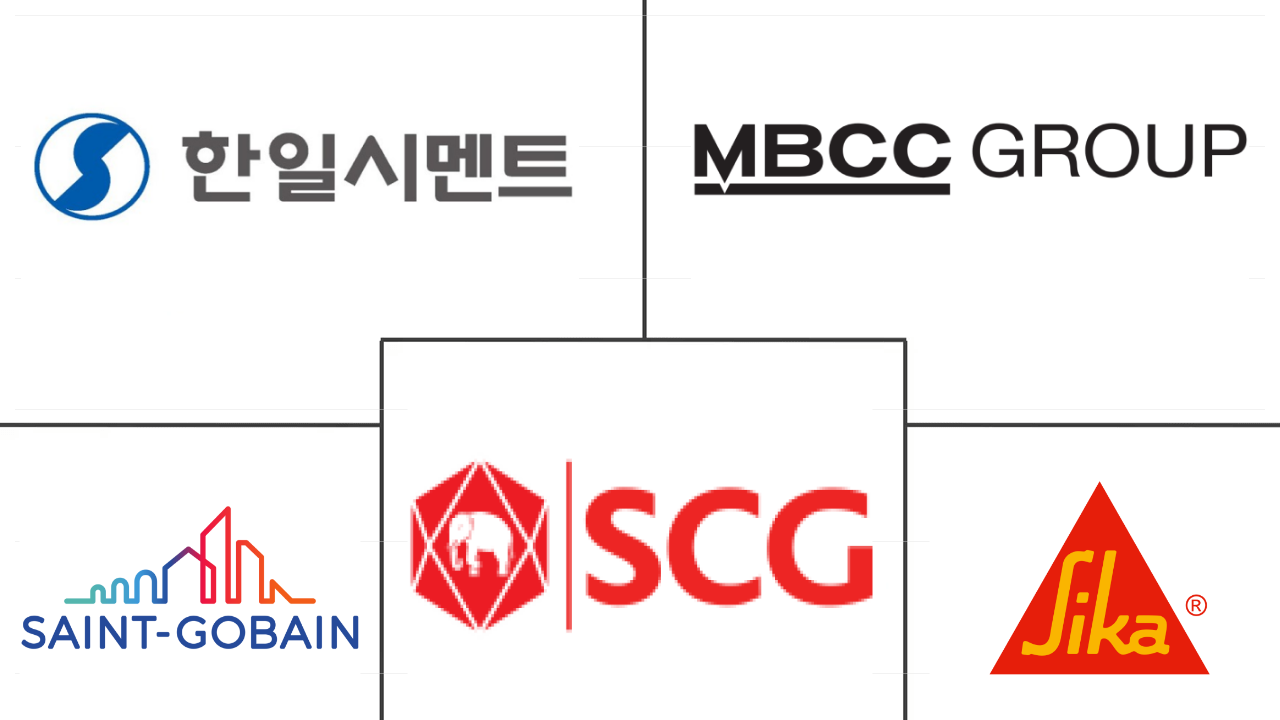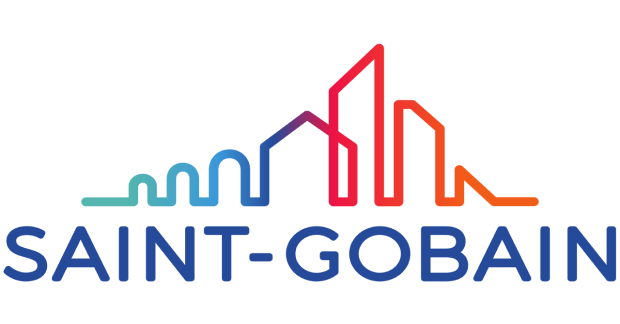Market Size of dry mix mortar Industry
| Icons | Lable | Value |
|---|---|---|
|
|
Study Period | 2018 - 2030 |
|
|
Market Volume (2024) | 350.93 Million Tons |
|
|
Market Volume (2030) | 482.16 Million Tons |
|
|
Largest Share by End Use Sector | Residential |
|
|
CAGR (2024 - 2030) | 5.44 % |
|
|
Largest Share by Region | Asia-Pacific |
|
|
Market Concentration | Low |
Major Players |
||

|
||
|
*Disclaimer: Major Players sorted in no particular order |
Dry Mix Mortar Market Analysis
The Dry Mix Mortar Market size is estimated at 350.93 million Tons in 2024, and is expected to reach 482.16 million Tons by 2030, growing at a CAGR of 5.44% during the forecast period (2024-2030).
350.93 Million
Market Size in 2024 (Tons)
482.16 Million
Market Size in 2030 (Tons)
3.00 %
CAGR (2018-2023)
5.44 %
CAGR (2024-2030)
Largest Market by Application
38.35 %
volume share, Render, 2023
Owing to the growing usage of renders for finishing concrete and cement surfaces, in the residential, industrial, and infrastructure sectors globally, the segment has dominated the market.
Largest Market by End Use Sector
62.21 %
volume share, Residential, 2023
Due to the increasing usage of dry-mix mortar for applications such as rendering, plastering, waterproofing, and tiling, for housing construction, the residential sector holds the largest share.
Largest Market by Region
40.65 %
volume share, Asia-Pacific, 2023
Owing to the growing construction industrial activity in the region coupled with the increasing demand for dry mix mortar in countries like China, India, Japan, and South Korea, the region has dominated the market.
Fastest Market by Region
6.09 %
Projected CAGR, Asia-Pacific, 2024-2030
Owing to growing investments in infrastructure projects, government initiatives, fast-paced urbanization and industrialization, the Asia Pacific region is expected to witness the fastest growth.
Leading Company
4.36 %
market share, Saint-Gobain, 2022

The company held the largest share in 2022 owing to its large production capacity of around 24.4 million tons of dry mix mortar per year. The company also serves customers across various construction sectors.
Growing commercial constructions in emerging countries, such as India's Grade A office, are expected to reach 1.2 billion square feet by 2030, augmenting the market's growth
- In 2022, global consumption of dry mix mortar saw a modest growth rate of 0.64%, driven by heightened demand from the infrastructure and commercial construction sectors. Notably, the infrastructure and commercial sectors saw growth rates of 3.42% and 1.0%, respectively, in 2022, compared to 2021. The global dry mix mortar market was projected to grow by approximately 4.29% in 2023.
- With a share of 62.34% in 2022, the residential sector stands as the largest consumer of dry mix mortar. Factors such as urbanization, government initiatives, and both foreign and domestic investments are fueling the demand for housing, leading to a surge in residential building construction. For example, Germany is set to construct a minimum of 4.0 thousand new housing units by 2024, while the Malaysian government aims to build around 500 thousand affordable housing units by 2025. Consequently, the dry mix mortar market for the residential sector is projected to witness a CAGR of 5.43% from 2023 to 2030.
- The commercial sector is poised to be the fastest-growing consumer of dry mix mortar, with a forecasted CAGR of 6.52%. This surge is attributed to the rising demand for shopping malls, office spaces, and other commercial structures. Highlighting this trend, India's Grade A office market in its top seven cities is expected to expand to approximately 1 billion square feet by 2026 and further to 1.2 billion square feet by 2030. In addition, the global commercial new floor area is projected to witness a substantial increase of 2.50 billion sq. ft. in 2030 compared to 2023. As a result, the global dry mix mortar consumption for the commercial sector is estimated to rise by 149 million tons from 2023 to 2030.
Fast-paced construction activities in the Asia-Pacific and South America predicted to bolster the demand for dry-mix mortar
- Dry-mix mortar plays a crucial role in both commercial and residential construction, finding applications in stucco, grouts, tile adhesives, and joint fillers. In 2022, the global dry-mix mortar market recorded a modest 0.64% growth in volume, a slowdown attributed to factors like inflation, surging raw material costs, and an impending recession. These challenges led to a dip in construction investments and project delays, dampening the demand for dry-mix mortar. However, a rebound was predicted, with the North American market poised to lead the way, projecting a 4.95% growth in volume from 2022 to 2023.
- Asia-Pacific held a dominant position in the dry-mix mortar market in 2022, accounting for a significant 130 million tons of the global share. Notably, countries like China, Japan, and India played pivotal roles in shaping this demand. In 2022, China's public spending on transport infrastructure rose to USD 165.6 billion, up from USD 157.6 billion in 2021. Japan witnessed a surge in manufacturing facility constructions, while India aimed to bolster its transportation network and provide affordable housing, fueling the construction sector's expansion.
- The Asia-Pacific region is poised to witness the highest growth rate, registering a CAGR of 6.09% in dry-mix mortar volume. South America follows closely, registering a CAGR of 5.54% during the forecast period. With governments and foreign investments backing major projects, the residential, infrastructure, and commercial construction sectors are expected to flourish, driving the demand for dry-mix mortar.
Dry Mix Mortar Industry Segmentation
Commercial, Industrial and Institutional, Infrastructure, Residential are covered as segments by End Use Sector. Concrete Protection and Renovation, Grouts, Insulation and Finishing Systems, Plaster, Render, Tile Adhesive, Water Proofing Slurries are covered as segments by Application. Asia-Pacific, Europe, Middle East and Africa, North America, South America are covered as segments by Region.
- In 2022, global consumption of dry mix mortar saw a modest growth rate of 0.64%, driven by heightened demand from the infrastructure and commercial construction sectors. Notably, the infrastructure and commercial sectors saw growth rates of 3.42% and 1.0%, respectively, in 2022, compared to 2021. The global dry mix mortar market was projected to grow by approximately 4.29% in 2023.
- With a share of 62.34% in 2022, the residential sector stands as the largest consumer of dry mix mortar. Factors such as urbanization, government initiatives, and both foreign and domestic investments are fueling the demand for housing, leading to a surge in residential building construction. For example, Germany is set to construct a minimum of 4.0 thousand new housing units by 2024, while the Malaysian government aims to build around 500 thousand affordable housing units by 2025. Consequently, the dry mix mortar market for the residential sector is projected to witness a CAGR of 5.43% from 2023 to 2030.
- The commercial sector is poised to be the fastest-growing consumer of dry mix mortar, with a forecasted CAGR of 6.52%. This surge is attributed to the rising demand for shopping malls, office spaces, and other commercial structures. Highlighting this trend, India's Grade A office market in its top seven cities is expected to expand to approximately 1 billion square feet by 2026 and further to 1.2 billion square feet by 2030. In addition, the global commercial new floor area is projected to witness a substantial increase of 2.50 billion sq. ft. in 2030 compared to 2023. As a result, the global dry mix mortar consumption for the commercial sector is estimated to rise by 149 million tons from 2023 to 2030.
| End Use Sector | |
| Commercial | |
| Industrial and Institutional | |
| Infrastructure | |
| Residential |
| Application | |
| Concrete Protection and Renovation | |
| Grouts | |
| Insulation and Finishing Systems | |
| Plaster | |
| Render | |
| Tile Adhesive | |
| Water Proofing Slurries | |
| Other Applications |
| Region | ||||||||||||||
| ||||||||||||||
| ||||||||||||||
| ||||||||||||||
| ||||||||||||||
|
Dry Mix Mortar Market Size Summary
The dry mix mortar market is experiencing a steady expansion, driven by increasing demand in the residential, commercial, and infrastructure sectors. The residential sector remains the largest consumer, fueled by urbanization and government initiatives promoting housing construction. The commercial sector is anticipated to be the fastest-growing segment, with rising demand for shopping malls and office spaces. The market's growth is supported by significant investments and projects in regions like Asia-Pacific, where countries such as China, India, and Japan are leading in construction activities. Despite challenges like inflation and raw material costs, the market is poised for recovery and growth, with North America expected to play a pivotal role in this resurgence.
Globally, the dry mix mortar market is characterized by its fragmented nature, with major players like HANIL HOLDINGS CO.,LTD., MBCC Group, Saint-Gobain, SCG, and Sika AG holding a modest share. Innovations in product formulations, such as LATICRETE International's lightweight, high-performance mortar, are contributing to market advancements. The market's growth trajectory is supported by government-backed initiatives and investments in affordable housing and infrastructure projects, particularly in South America and Asia-Pacific. As construction activities ramp up post-pandemic, the market is set to benefit from the resurgence in both residential and commercial construction, with a positive outlook for the coming years.
Dry Mix Mortar Market Size - Table of Contents
-
1. MARKET SEGMENTATION (includes market size, forecasts up to 2030 and analysis of growth prospects.)
-
1.1 End Use Sector
-
1.1.1 Commercial
-
1.1.2 Industrial and Institutional
-
1.1.3 Infrastructure
-
1.1.4 Residential
-
-
1.2 Application
-
1.2.1 Concrete Protection and Renovation
-
1.2.2 Grouts
-
1.2.3 Insulation and Finishing Systems
-
1.2.4 Plaster
-
1.2.5 Render
-
1.2.6 Tile Adhesive
-
1.2.7 Water Proofing Slurries
-
1.2.8 Other Applications
-
-
1.3 Region
-
1.3.1 Asia-Pacific
-
1.3.1.1 By Country
-
1.3.1.1.1 Australia
-
1.3.1.1.2 China
-
1.3.1.1.3 India
-
1.3.1.1.4 Indonesia
-
1.3.1.1.5 Japan
-
1.3.1.1.6 Malaysia
-
1.3.1.1.7 South Korea
-
1.3.1.1.8 Thailand
-
1.3.1.1.9 Vietnam
-
1.3.1.1.10 Rest of Asia-Pacific
-
-
-
1.3.2 Europe
-
1.3.2.1 By Country
-
1.3.2.1.1 France
-
1.3.2.1.2 Germany
-
1.3.2.1.3 Italy
-
1.3.2.1.4 Russia
-
1.3.2.1.5 Spain
-
1.3.2.1.6 United Kingdom
-
1.3.2.1.7 Rest of Europe
-
-
-
1.3.3 Middle East and Africa
-
1.3.3.1 By Country
-
1.3.3.1.1 Saudi Arabia
-
1.3.3.1.2 United Arab Emirates
-
1.3.3.1.3 Rest of Middle East and Africa
-
-
-
1.3.4 North America
-
1.3.4.1 By Country
-
1.3.4.1.1 Canada
-
1.3.4.1.2 Mexico
-
1.3.4.1.3 United States
-
-
-
1.3.5 South America
-
1.3.5.1 By Country
-
1.3.5.1.1 Argentina
-
1.3.5.1.2 Brazil
-
1.3.5.1.3 Rest of South America
-
-
-
-
Dry Mix Mortar Market Size FAQs
What is the current Global Dry Mix Mortar Market size?
The Global Dry Mix Mortar Market is projected to register a CAGR of 5.44% during the forecast period (2024-2030).
Who are the key players in Global Dry Mix Mortar Market?
HANIL HOLDINGS CO.,LTD., MBCC Group, Saint-Gobain, SCG and Sika AG are the major companies operating in the Global Dry Mix Mortar Market.

